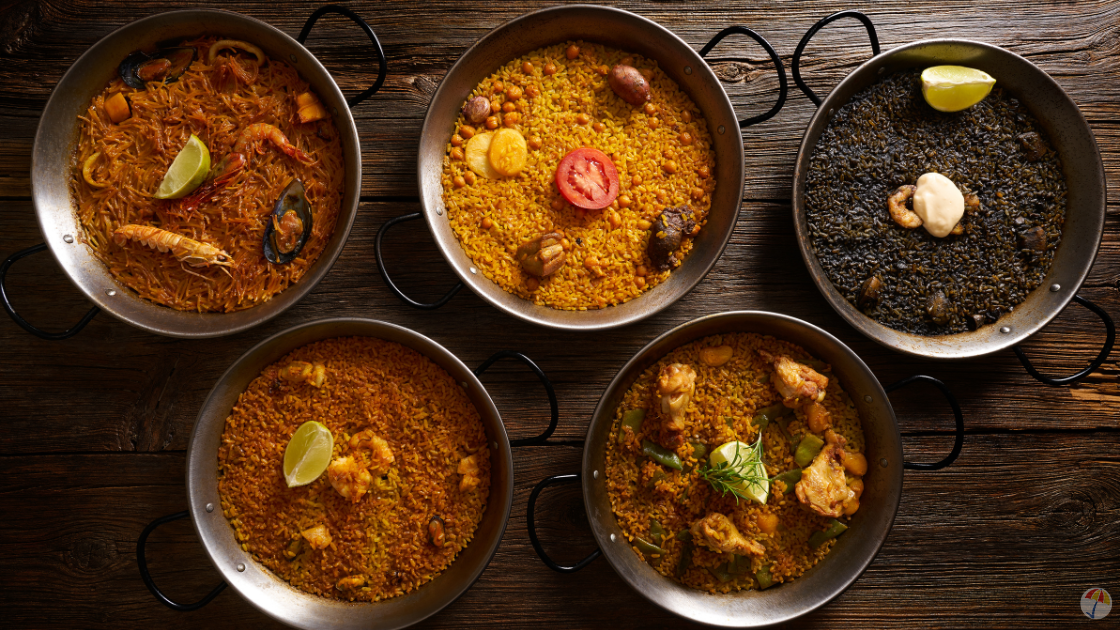
What is Paella? | Origins, Varieties, and Perfect Pairings
|
|
Time to read: 5 min
|
|
Time to read: 5 min
Paella is a traditional Spanish dish. It is made with rice, vegetables and various meats such as chicken, rabbit or seafood. It is cooked in a large, shallow pan called a paella or paellera. The dish is famous for its rich flavours and the use of saffron, which gives it a golden colour. Today there are many types of paella, but all are a delicious part of Spanish cuisine.
Paella has some essential ingredients, but the beauty of the dish is that every cook and family adds their own twist.
At its core, paella is made with short-grain rice ('arroz bomba'), saffron for its distinctive golden colour, and olive oil. The traditional paella Valenciana contains chicken, rabbit and a mixture of green beans and garrofón (large white beans). However, many variations add seafood, vegetables or even different spices.
Living on the Costa del Sol in Spain, I've tried many types of paella, but my personal favourites are Paella de Mariscos and Paella Negra. The fresh seafood and unique flavours make every bite memorable!
The origin of the name "paella" is as controversial as the authenticity of the dish itself. There are three interesting stories about the origin of the name, and I am happy to share them with you:
Each of these stories adds its own charm to this beloved dish. But whatever the true story, it doesn't change the fact that paella remains one of the most popular and cherished dishes in Spain and around the world!
Where Does Authentic Paella Come From? The True Story Of Its Roots
Five years ago, we were fortunate to embark on our journey in Spain, starting in Valencia. There, we experienced the most exquisite Spanish paella. We later discovered that this is because it is traditionally served in its home town.
Paella comes from Valencia, a region on the eastern coast of Spain. Paella is a simple meal that originated with farmers over 200 years ago. They used rice, fresh vegetables, and whatever meat they had, like rabbit or chicken. Initially, paella included snails because they were easy to find.
Valencia has always been known for its rice fields, thanks to the Moors who brought rice to Spain. Over time, paella became a favourite dish all over the country and later around the world.
Like almost every first-time expat in Spain, we have made some common mistakes that have broken the paella rules and given local chefs heart attacks (once we asked to put some Parmegiano on it...uups).
So we thought it would be useful to list some of the Do's and Don'ts when eating paella in Spain:
From our own experience, there are some foods that are "allowed" to be eaten with paella and others that must be avoided at all costs.
Here we would like to visualise all the do's and don'ts as a pairing to the Spanish paella:
Do's |
Don'ts |
| ✅ Light, fruity red wine like Tempranillo or a strong white wine such as Chardonnay |
❌ Extra Salt or spices |
| ✅ Olives, alioli (garlic mayonnaise) |
❌ Bread |
| ✅ Light desserts such as lemon sorbet, Catalan cream or ice cream |
❌ Overly Sweet Desserts like chocolate cake or the popular Spanish 'Dulce de leche' (milk candy dessert) |
My advice to you (especially if this is your first paella): Keep it simple and let the paella shine! The aim is to preserve the original taste of the paella in your mouth, not to overshadow or ruin it with overpowering side dishes.
There are many ways to describe paella, but words can only go so far. To truly understand its unique flavour, you have to come to Spain and try it for yourself, ideally in a local restaurant in Valencia where it all began.
Based on what most people search on Google about paella, I've put together some key facts and frequently asked questions in the 👇FAQ section to give you more insight into this iconic dish. Enjoy exploring, but don't forget - the real paella experience is best had here in Spain!
Paella is pronounced 'pa-eh-ya'. The Spanish 'll' sounds like the English 'y', so it's not 'pa-ella' but 'pa-eh-ya'. Tip from personal experience: Play any YouTube video in Spanish about paella and you will get it right away.
Yes, paella can be healthy! It's made with fresh ingredients such as vegetables, seafood and lean meat. Just watch the portion size as it can be filling!
Yes, traditional paella (Paella Valenciana) is gluten-free, as it’s made with rice, meats, seafood, vegetables, and spices. Just ensure no gluten-containing broths or added ingredients are used.
Paella can be high in calories, especially if it contains fatty meats or extra oil. However, using lean meats, seafood and plenty of vegetables can make it a lighter option. Moderation is the key!
Yes, paella is a traditional Spanish dish that has its origins in Valencia, on the east coast of Spain.
Paella is typically dry with a slightly moist texture. The rice absorbs the broth, making it flavourful but not soupy.
No, traditional paella is not spicy. It's seasoned with ingredients like saffron, garlic and paprika, but it doesn't usually contain hot spices.
Paella is not a tourist trap. Some touristy spots serve overpriced or low-quality paella, but many local restaurants, especially in places like Valencia, offer authentic and delicious versions. Choose the right place and you'll have a great experience!



